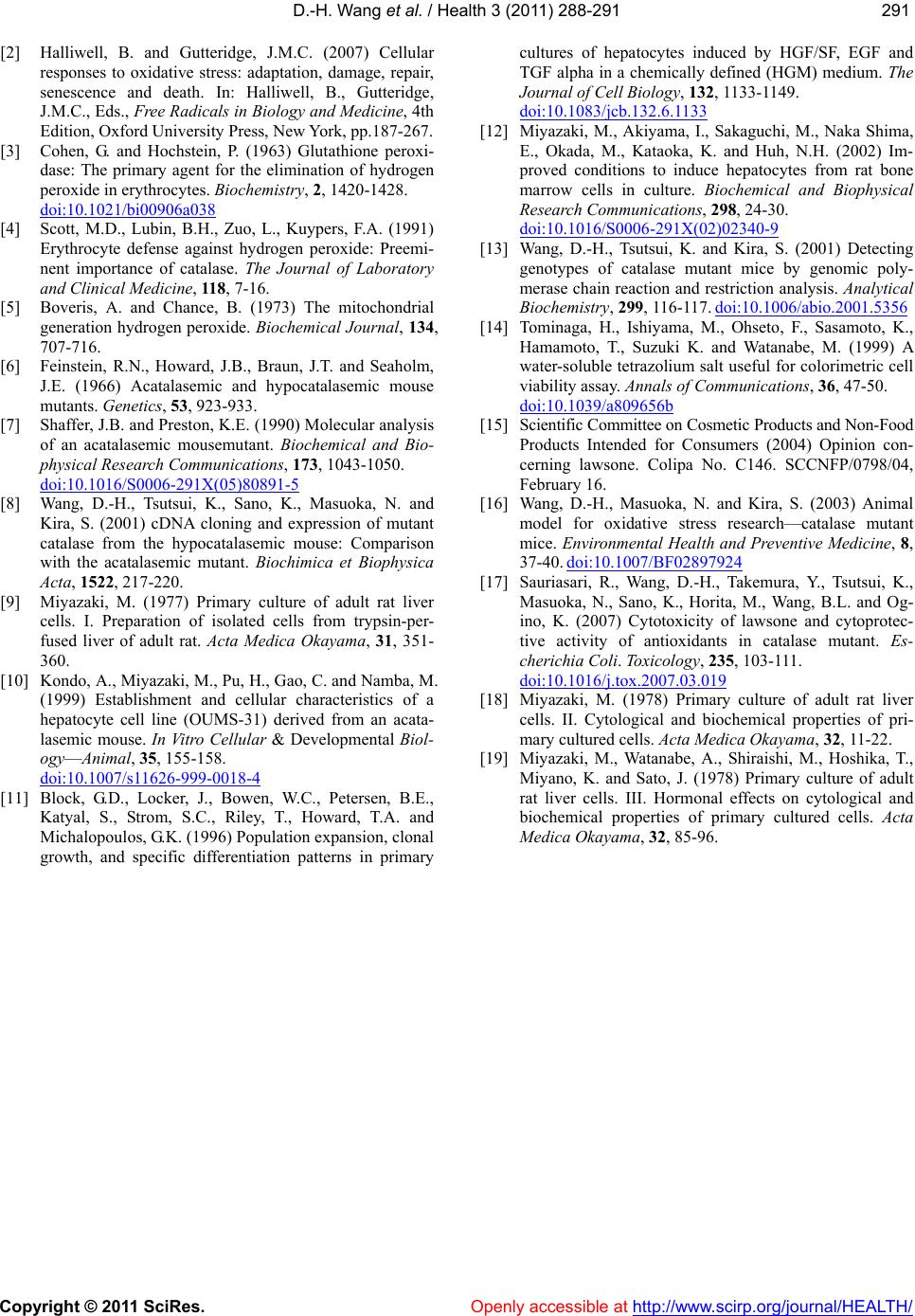
D.-H. Wang et al. / Health 3 (2011) 288-291
Copyright © 2011 SciRes. http://www.scirp.org/journal/HEALTH/Openly accessible at
291291
[2] Halliwell, B. and Gutteridge, J.M.C. (2007) Cellular
responses to oxidative stress: adaptation, damage, repair,
senescence and death. In: Halliwell, B., Gutteridge,
J.M.C., Eds., Free Radicals in Biology and Medicine, 4th
Edition, Oxford University Press, New York, pp.187-267.
[3] Cohen, G. and Hochstein, P. (1963) Glutathione peroxi-
dase: The primary agent for the elimination of hydrogen
peroxide in erythrocytes. Biochemistry, 2, 1420-1428.
doi:10.1021/bi00906a038
[4] Scott, M.D., Lubin, B.H., Zuo, L., Kuypers, F.A. (1991)
Erythrocyte defense against hydrogen peroxide: Preemi-
nent importance of catalase. The Journal of Laboratory
and Clinical Medicine, 118, 7-16.
[5] Boveris, A. and Chance, B. (1973) The mitochondrial
generation hydrogen peroxide. Biochemical Journal, 134,
707-716.
[6] Feinstein, R.N., Howard, J.B., Braun, J.T. and Seaholm,
J.E. (1966) Acatalasemic and hypocatalasemic mouse
mutants. Genetics, 53, 923-933.
[7] Shaffer, J.B. and Preston, K.E. (1990) Molecular analysis
of an acatalasemic mousemutant. Biochemical and Bio-
physical Research Communications, 173, 1043-1050.
doi:10.1016/S0006-291X(05)80891-5
[8] Wang, D.-H., Tsutsui, K., Sano, K., Masuoka, N. and
Kira, S. (2001) cDNA cloning and expression of mutant
catalase from the hypocatalasemic mouse: Comparison
with the acatalasemic mutant. Biochimica et Biophysica
Acta, 1522, 217-220.
[9] Miyazaki, M. (1977) Primary culture of adult rat liver
cells. I. Preparation of isolated cells from trypsin-per-
fused liver of adult rat. Acta Medica Okayama, 31, 351-
360.
[10] Kondo, A., Miyazaki, M., Pu, H., Gao, C. and Namba, M.
(1999) Establishment and cellular characteristics of a
hepatocyte cell line (OUMS-31) derived from an acata-
lasemic mouse. In Vitro Cellular & Developmental Biol-
ogy—Animal, 35, 155-158.
doi:10.1007/s11626-999-0018-4
[11] Block, G.D., Locker, J., Bowen, W.C., Petersen, B.E.,
Katyal, S., Strom, S.C., Riley, T., Howard, T.A. and
Michalopoulos, G.K. (1996) Population expansion, clonal
growth, and specific differentiation patterns in primary
cultures of hepatocytes induced by HGF/SF, EGF and
TGF alpha in a chemically defined (HGM) medium. The
Journal of Cell Biology, 132, 1133-1149.
doi:10.1083/jcb.132.6.1133
[12] Miyazaki, M., Akiyama, I., Sakaguchi, M., Naka Shima,
E., Okada, M., Kataoka, K. and Huh, N.H. (2002) Im-
proved conditions to induce hepatocytes from rat bone
marrow cells in culture. Biochemical and Biophysical
Research Communications, 298, 24-30.
doi:10.1016/S0006-291X(02)02340-9
[13] Wang, D.-H., Tsutsui, K. and Kira, S. (2001) Detecting
genotypes of catalase mutant mice by genomic poly-
merase chain reaction and restriction analysis. Analytical
Biochemistry, 299, 116-117. doi:10.1006/abio.2001.5356
[14] Tominaga, H., Ishiyama, M., Ohseto, F., Sasamoto, K.,
Hamamoto, T., Suzuki K. and Watanabe, M. (1999) A
water-soluble tetrazolium salt useful for colorimetric cell
viability assay. Annals of Communications, 36, 47-50.
doi:10.1039/a809656b
[15] Scientific Committee on Cosmetic Products and Non-Food
Products Intended for Consumers (2004) Opinion con-
cerning lawsone. Colipa No. C146. SCCNFP/0798/04,
February 16.
[16] Wang, D.-H., Masuoka, N. and Kira, S. (2003) Animal
model for oxidative stress research—catalase mutant
mice. Environmental Health and Preventive Medicine, 8,
37-40. doi:10.1007/BF02897924
[17] Sauriasari, R., Wang, D.-H., Takemura, Y., Tsutsui, K.,
Masuoka, N., Sano, K., Horita, M., Wang, B.L. and Og-
ino, K. (2007) Cytotoxicity of lawsone and cytoprotec-
tive activity of antioxidants in catalase mutant. Es-
cherichia Coli. Toxicology, 235, 103-111.
doi:10.1016/j.tox.2007.03.019
[18] Miyazaki, M. (1978) Primary culture of adult rat liver
cells. II. Cytological and biochemical properties of pri-
mary cultured cells. Acta Medica Okayama, 32, 11-22.
[19] Miyazaki, M., Watanabe, A., Shiraishi, M., Hoshika, T.,
Miyano, K. and Sato, J. (1978) Primary culture of adult
rat liver cells. III. Hormonal effects on cytological and
biochemical properties of primary cultured cells. Acta
Medica Okayama, 32, 85-96.